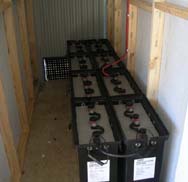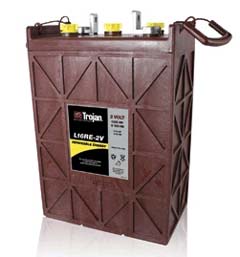|
Off-Grid Home with Electric Car (February
18, 2011)
|
 |
| A while back I got
an email from a guy who lives in a nice house high in the Colorado Mountains using
an off-grid power system. He was planning on buying a plug-in hybrid car.
He wondered how many more solar panels he would have to add to his system to keep
his car charged up without ever burning a drop of gasoline. He said that his
commutes into town were almost always less than 50 miles per day. He wanted to
be able to charge up his carís battery during the night, drawing power from his main
storage battery, which is charged during the day using the solar panels. Letís
see what it would take. |
|
|
| I
know a local hybrid car dealer who told me once that it takes about 25
kilowatt-hours of energy to drive hybrid car 100 miles. This was for a
modified Toyota Prius. Some hybrid cars will get better mileage and some will
get less. But, this might be a good place to start. |
| At 25
kilowatt-hours per 100 miles, the off-grid home owner, who wants to go 50 miles,
will need 12.5 kilowatt-hours to operate his car on battery power alone. There
are losses every step in the process of converting sunlight into stored energy in
the electric carís battery. I figure that an overall efficiency of about 60%
should be a reasonable figure. Remember, the electric car will have to pull
power from the off-grid storage battery, since the car will be charging at night
when there is no sunshine. There are some losses from the solar panel output
to the off-grid storage battery. There are additional losses from the storage
battery to the AC power output of the DC to AC inverter. Finally, there are
losses in the hybridís own battery charger which draws power from the 120vac
inverter output. |
| OK,
letís work backwards. We need 12.5 kilowatt-hours of energy in the electric
carís battery. If we divide 12.5 by 0.6 we get 21 kilowatt-hours of energy
from the solar panels. I like to use a figure of 6 for the average number of
sunlight hours each day. Some days will be longer and some will be shorter. If
we divide 21 kilowatt hours by 6 we get 3.5 kilowatts worth of solar panels that
will be needed on the homeownerís roof. Typical solar panels today crank out
250 watts per panel, so our off-grid home owner will need to buy at least 14 more
solar panels. I would throw in one more for good measure, making total 15 panels. |
 |
OK, so the
homeowner will need 15 additional 250 watt solar panels to charge his electric
car. Now, how much bigger will he need to make his energy storage
battery? From above, we figured that the hybrid will need about
13KH-hours of energy to go 50 miles.
I figure that both the
hybridís battery charger and the DC to AC inverter will each have an
efficiency of about 85%. So, if we divide 13 by 0.72 we get 18
kilowatt-hours from the main homeís storage battery.
Just for the electric
car. Most large off-grid systems use 48v lead acid batteries. If
you divide 18,000 by 48 you get about 400 Amp-hours. But, to insure a long
battery life, the actual battery capacity should be increased to twice this
figure, making the final figure for a battery capacity at about 1000
Amp-hours. This would just about double the size of the battery bank the home
owner now uses. |
|
250 Watt
Solar Panel |
|
|
| One thousand
Amp-hour lead acid batteries are monsters. Each weighs about 250 pounds.
If the home owner is serious about staying off-grid and keeping a plug-in
hybrid charged, he is going to have double up and have a total of 48 1000 Amp
hour cells. He will also have to look over his whole electrical system.
The DC to AC inverters
may have to be increased in size as well. The owner may also have to
increase the size of his battery charge controller and all the electrical
boxes to handle the added power. But, when done, he would have a nice
power system which will not require a drop of gasoline or diesel oil. |
 |
 |
| |
48v 1000 Amp-hour Battery Bank |
2v 1000 Amp-hour Lead Acid Cell |
|
|